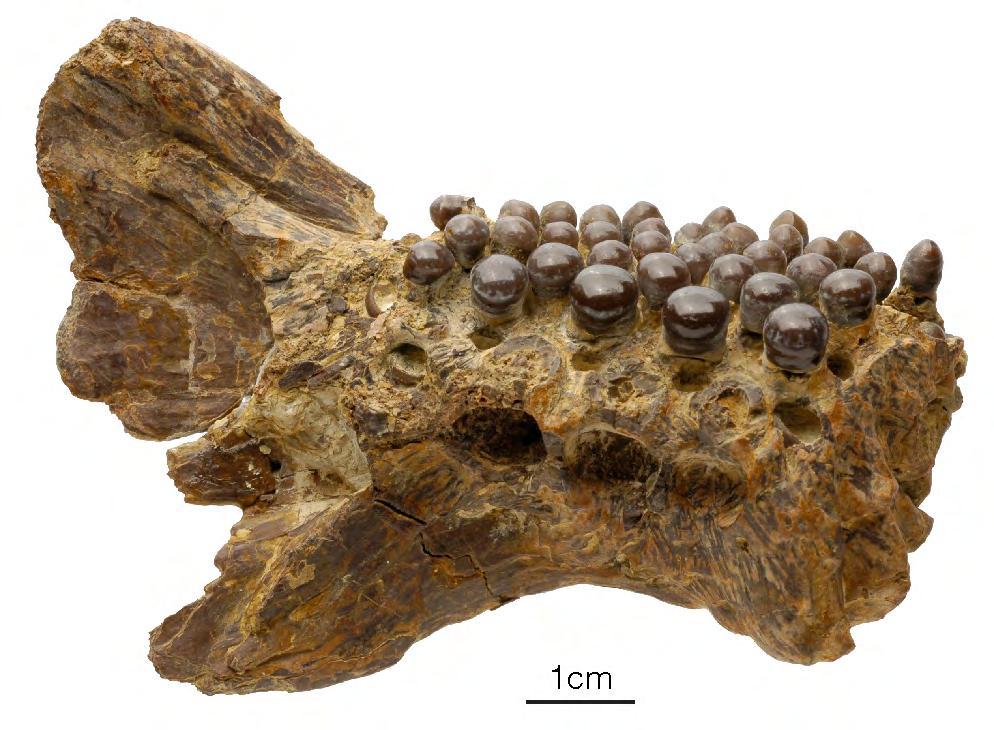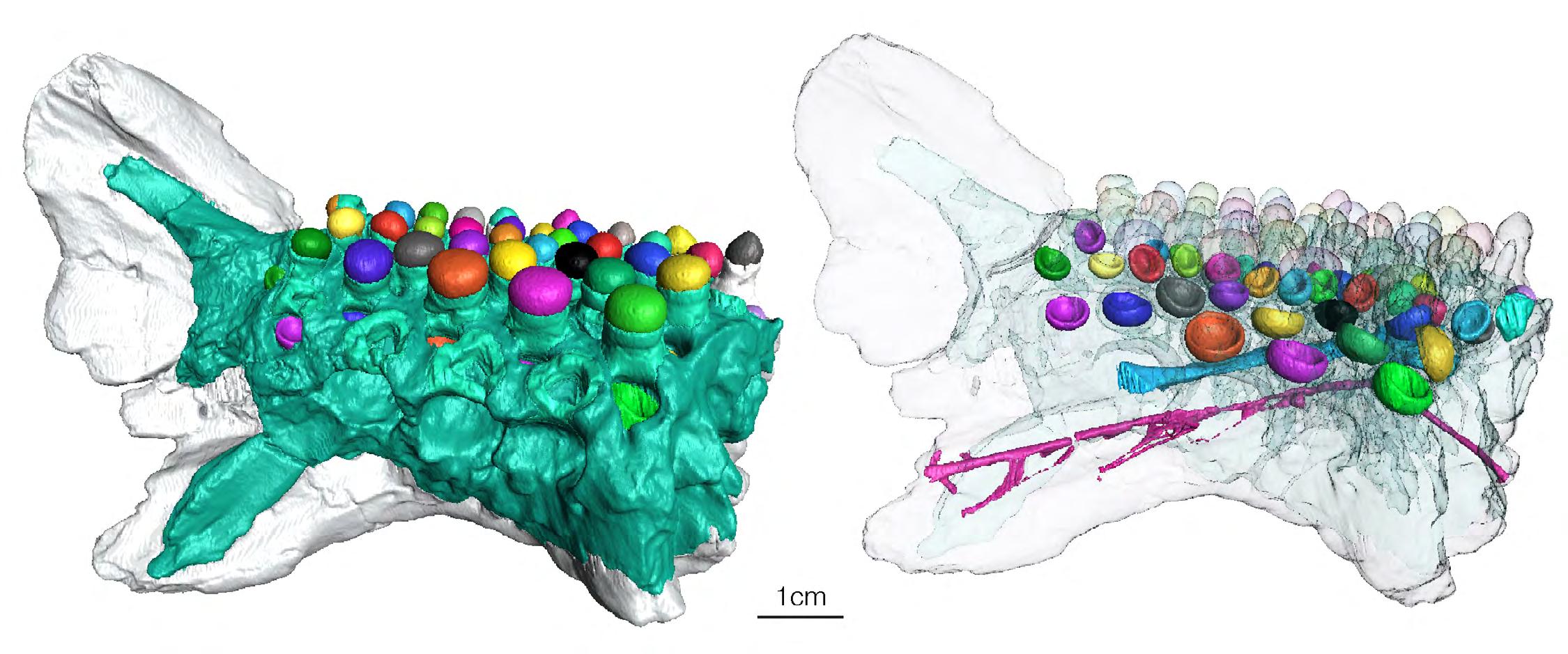
8 minute read
SCIENCE
Micro-computed tomography reveal a new kind of tooth replacement in vertebrates
The internal structure of fossils can be explored through the nondestructive technique of X-ray micro-computed tomography (μCT). Tissues of different densities (e.g. bone, tooth enamel, tooth dentine) or cavities left by nerves or blood vessels are translated into different levels of gray on the computer, which allows the paleontologist to select (“segment”) similar tissues through all the sections of a 3D object.
Advertisement
The segmented specimen can then be visualized as a 3D model and the scientist can “navigate” through it, rotating the object, hiding certain tissues or cutting off the fossil at a given point to see its internal structure in section. A recent study on a prehistoric fish made some discoveries new to science. A contributor to the study, Lea Léuzinger, shares more about the techniques used and the findings here.
Above: Fig. 1) Photograph of a lower hemimandible of the Jurassic bony fish Scheenstia sp. (MJSN TCH005-353) uncovered by the Paléontologie A16 team in the Swiss Jura. Lingual view. Source: Figure derives from open-access publication LEUZINGER, L., CAVIN, L., LÓPEZ-ARBARELLO, A. and BILLON-BRUYAT, J.-P. 2019. Peculiar tooth renewal in a Jurassic ray-finned fish (Lepisosteiformes, Scheenstia sp.). Palaeontology, 1–13. Creative Commons license applies.
Q & A - Léa Leuzinger
Have you always had an interest in the geological sciences as well as the arts?
As a paleontologist, I am actually more into plants and animals than into earth processes, rocks and minerals. Since I was a child, I have always loved animals and especially bugs, although I was also very fond of documentaries about natural disasters such as earthquakes and volcanoes.
As for arts, I have always been in contact with dancing, music and visual arts, especially through my mother. She took me and my sisters to dance classes since we were 6 years old, and dancing is still a necessary part of my balance. As for the music, I play the piano since I am a child and I am now exploring drums. I was also much into drawing as a teenager and liked sketching during practical classes of biology and paleontology.
Arts are an indispensable part of my life, and during my studies, I have worked in both natural history and art museums, namely the HG Giger museum. The aesthetics of fossils, especially teeth and microfossils are one the aspects of paleontology that attract me most, although I can be quite distanced from it through my specialization in stable isotope analyses. I like the hidden beauty of tiny fossils that can only be appreciated under a binocular or microscope.
When I decided to study paleontology, I was actually hesitating with a school of arts and multimedia where I was wanting to study videogame design.
A paleontology teacher told me that many of his geologist colleagues had a side activity in arts, if this could help me decide. To this day, there are still moments when I wonder what my life would have been like as an illustrator, graphic or videogame designer.

Above: Fig. 1) Photograph of a lower hemimandible of the Jurassic bony fish Scheenstia sp. (MJSN TCH005-353) uncovered by the Paléontologie A16 team in the Swiss Jura. Lingual view.Fig. 2) 3D reconstruction of the same remains based on micro-computed x-ray tomography. On the left, the entire specimen. White = dentary bone, turquoise blue = prearticular-coronoid bone, other colors = enameloid of single tooth pairs; On the right, internal structure of the remain that reveals, under every functional tooth, a replacement tooth in the same color, developing in an upside-down position, as well as the main nervous canals.
In your main research, how do you use stable isotope analyses to investigate fossil specimens? As presented in your 2019 Wiley publication, please explain how you discovered a unique mode of tooth replacement in vertebrates?
I use carbon and oxygen stable isotopes on fossils to get information on their ecology and environment. Contrary to radioactive isotopes, stable isotopes do not decay and, consequently, cannot be used for dating.
The oxygen and carbon present in biological tissues mainly come from the ingested water and diet, respectively. They are thus intimately linked to the water and carbon cycle and consequently good indicators of environmental parameters at play during these cycles, such as aridity, temperature, habitat and food source.
Although the stable isotope composition of fossil remains can suffer alteration, some biomineralized tissues are especially resistant and their stable isotope composition has shown to be close to original values. This is the case of teeth (especially enamel) or eggshells. I have focused on Mesozoic (the era comprized between 245 and 65 million years ago) vertebrate remains and especially teeth of diverse taxa and titanosaur dinosaur eggshells. Among the fossils uncovered during the construction of a highway in the Swiss Jura, there was a hemimandible of a bony fish, emblematic of the Mesozoic era (Scheenstia, formerly referred to Lepidotes), preserved in 3D and with the teeth still in place.
It was quite unique for this site, since most teeth were found isolated. On the lower part of the mandible, teeth that were apparently developing replacement teeth, were poking out of the bone and seemed to be upside down. Lionel Cavin, a paleoichthyologist and co-author of the publication was surprised by this feature that he had never seen in bony fish, and suggested to dig further into it using micro computed tomography (µCT-scanning).
This non-destructive method allows to explore the fossil in 3 dimensions and differentiate the tissues by density (bone, dentine, enamel, cavities left by nerves or vessels).
We built a tridimensional model of the fossil that helped us understand much of the dental renewal in Scheenstia: we now know that each functional tooth has its own replacement tooth, the replacement teeth first mineralize upside-down, then rotate and erupt in a synchronous fashion, and each replacement tooth forms in a separate cavity within the bone called crypt, implying an individual blood and nervous supply.
During the writing of the manuscript, we realized that this type of dental renewal was not observed in any other vertebrate and was thus new to science, although several authors had mentioned the presence of upside-down replacement teeth in mandibles of this genus in the 19th and early 20th century already.
Back then however, they did not have the technology to explore the internal structure of the fossils and explain the replacement mechanism.
The first fossils I analyzed during my Master’s were cartilaginous fish (rays, sharks and chimaeras) and bony fish teeth and scales. During the PhD, I moved to terrestrial realms and focused on dinosaur eggs, as well as archosauromorph teeth (the lineage of crocodiles, dinosaurs, plus other extinct “...we realized taxa). that this type In a side project, I have also worked of dental with teeth of marine reptiles (mosasaurs renewal was not and plesiosaurs), and I am now studying observed in any an association of crocodyliforms, other vertebrate dinosaurs, sharks and bony fish teeth from and was thus Uruguay, including coelacanth and new to science.” lungfish. Tooth plates of lungfish are among the most beautiful fossils I have sampled.
What plans do you have next for your research and projects in the near future?
I am planning to explore physiological aspects of egg formation and their influence on the stable isotope composition in fossil eggs. I am also interested to add stable isotope data of Mesozoic fossils to my database, to interpret the data at a larger scale.
Data of marine invertebrates would also be very useful, since they can be good indicators of water temperature at a more global scale.
With my colleagues and co-authors of the study on tooth replacement, we are planning to explore the dental renewal of other fish related to Scheenstia with µCT-scanning to understand the frequency and phylogenic repartition of this peculiar “upsidedown” replacement that we described. In parallel, I will collaborate in the elaboration of an inventory of Mesozoic fish teeth for a museum in Switzerland.
For the future, I would like to keep on working with aquatic animals which I find more attractive than terrestrial ones. It is also important to me to keep a foot in the world of Swiss fossils.
I also miss sharks quite a lot and would like to work again on the identification of a fish assemblage, go back to descriptions and drawing, to compensate for numbers and Excel sheets...!
Final thoughts
Beside this work on fish tooth replacement based on microcomputer tomography, Léa’s main research topic actually refers to paleoenvironmental and paleoecological reconstructions based on carbon and oxygen stable isotope analyses.
With this technique, she has analyzed teeth of fossil bony fish, sharks, rays, mosasaurs, as well as dinosaur eggs and teeth to get information on the aridity conditions, the air and water temperature, and the food source and foraging ground of the studied animals.
Léa next aims to focus on aquatic animals, and further explore the effects of dinosaur egg formation on their stable isotopic composition.
Bio
Léa Leuzinger is a Swiss paleontologist based in Argentina. She specialized in stable isotope analyses on fossils and their application in paleoenvironmental reconstruction during her Master’s degree in Earth Sciences at the University of Fribourg, Switzerland, and her PhD in Geological Sciences at the University of Cordoba, Argentina. She is currently a post-doctoral fellow at the University of Buenos Aires.
Her main field of interest is in the stable isotope composition of Mesozoic vertebrates, although she also works on fish dental renewal based on micro-computed tomography.
Links
Researchgate: www.researchgate.net/ profile/Lea_Leuzinger
Email: leuzinger.lea@gmail.com








